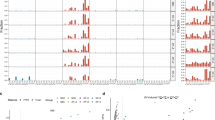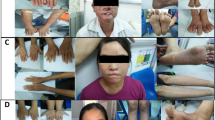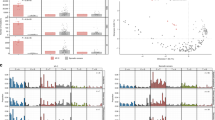Abstract
XERODERMA pigmentosum (XP) is an autosomal recessive disorder characterized by a high frequency of skin cancer on sun-exposed areas, and neurological complications. XP has a defect in the early step(s) of nucleotide-excision repair (NER) and consists of eight different genetic complementation groups (groups A–G and a variant)1. We established XPA (group-A XP) gene-deficient mice by gene targeting of mouse embryonic stem (ES) cells. The XPA-deficient mice showed neither obvious physical abnormalities nor pathological alterations, but were defective in NER and highly susceptible to ultraviolet-B- or 9,10-dimethyl-l,2-benz[a]anthra-cene-induced skin carcinogenesis. These findings provide in vivo evidence that the XPA protein protects mice from carcinogenesis initiated by ultraviolet or chemical carcinogen. The XP A -deficient mice may provide a good in vivo model to study the high incidence of skin carcinogenesis in group A XP patients.
This is a preview of subscription content, access via your institution
Access options
Subscribe to this journal
Receive 51 print issues and online access
$199.00 per year
only $3.90 per issue
Buy this article
- Purchase on Springer Link
- Instant access to full article PDF
Prices may be subject to local taxes which are calculated during checkout
Similar content being viewed by others
References
Aboussekhra, A. & Wood, R. D. Curr. Opin. Genet. Dev. 4, 212–220 (1994).
Tanaka, K., Satokata, I., Ogita, Z., Uchida, T. & Okada, Y. Proc. natn. Acad. Sci. U.S.A. 86, 5512–5516 (1989).
Tanaka, K. et al. Nature 348, 73–76 (1990).
Robins, P., Jones, C. J., Biggerstaff, M., Lindahl, T. & Wood, R. D. EMBO J. 10, 3913–3921 (1991).
Asahina, H. et al. Mutat. Res. 315, 229–237 (1994).
Jones, C. J. & Wood, R. D. Biochemistry 32, 12096–12104 (1993).
Matsuda, T. et al. J. biol. Chem. 270, 4152–4157 (1995).
He, Z., Henricksen, L. A., Wold, M. S. & Ingles, C. J. Nature 374, 566–569 (1995).
Li, L., Elledge, S. J., Peterson, C. A., Bales, E. S. & Legerski, R. J. Proc. natn. Acad. Sci. U.S.A. 91, 5012–5016 (1994).
Park, C., Mu, D., Reardon, J. T. & Sancar, A. J. biol. Chem. 270, 4896–4902 (1995).
Bradley, A., Hasty, P., Davis, A. & Ramirez-Solis, R. Bio/Technology 10, 534–539 (1992).
Cleaver, J. E. & Kraemer, K. H. in The Metabolic Basis of Inherited Disesase Vol 2 (eds Scriver, C. R., Beaudet, A. L. Sly, W. S. & Valle, D.) 2949–2971 (McGraw-Hill, New York, 1989).
Mansour, S. L., Thomas, K. R. & Capecchi, M. R. Nature 336, 348–352 (1988).
Tokunaga, T. & Tsunoda, Y. Dev. Growth Different. 34, 561–566 (1992).
Matsunaga, T., Mori, T. & Nikaido, O. Mutat. Res. 235, 187–194 (1990).
Tanaka, K., Takebe, H. & Okada, Y. Somatic Cell Genet. 6, 739–749 (1980).
Ikai, K., Danno, K., Horio, T. & Narumia, S. Arch. Derm. Res. 278, 445–448 (1986).
Author information
Authors and Affiliations
Rights and permissions
About this article
Cite this article
Nakane, H., Takeuchi, S., Yuba, S. et al. High incidence of ultraviolet-B-or chemical-carcinogen-induced skin tumours in mice lacking the xeroderma pigmentosum group A gene. Nature 377, 165–168 (1995). https://doi.org/10.1038/377165a0
Received:
Accepted:
Issue Date:
DOI: https://doi.org/10.1038/377165a0
Comments
By submitting a comment you agree to abide by our Terms and Community Guidelines. If you find something abusive or that does not comply with our terms or guidelines please flag it as inappropriate.



